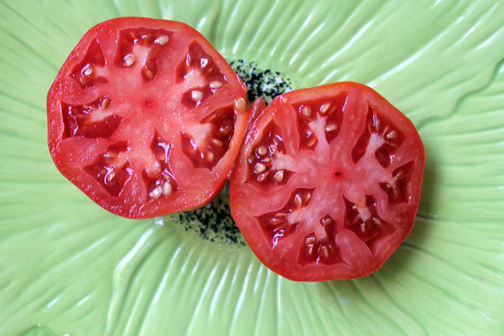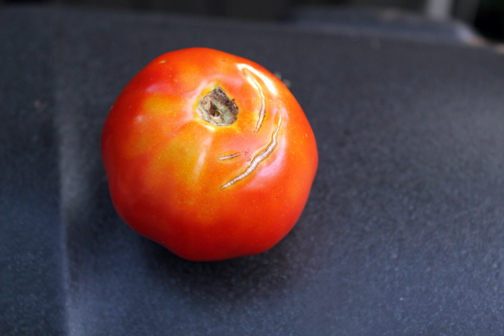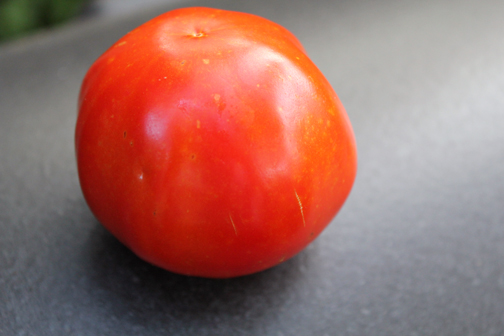Perhaps A Tomato Variety of My Very Own
 Accidents happen in the life, and when your garden is your life, accidents happen there too. For example, mixing up the Aunt Ruby's German Greens with the Pineapples, cutting the main stem of a plant and not the branch, and stepping on a tray of seedlings. Just a few select examples of my accidents.
Accidents happen in the life, and when your garden is your life, accidents happen there too. For example, mixing up the Aunt Ruby's German Greens with the Pineapples, cutting the main stem of a plant and not the branch, and stepping on a tray of seedlings. Just a few select examples of my accidents.
There's another kind of accident, which I'm not really sure it's called, but here's what happened. A few years ago, I honestly can't say how many, but it was more than six, I grew an Orange Oxheart tomato plant, and Cherokee Purple tomato plant. Two very distinct tomatoes in color, shape and size. One is a large oxheart shape, with a deep, rich orange color, and the other, a wide beefsteak variety with Joan Crawford-like shoulders that tend to stay green while the rest of the tomato, is a deep dusky, earthy red.
This odd-looking tomato formed on the Cherokee Purple plant that year, which looked like a oxheart on the left, and beefsteak on the right, I thought to myself, how about that. It formed late in the season, just about mid September, and here in my part of New Jersey, tomatoes in an open field will ripen until mid October. I live in a grove of oak trees, and when I grew these plants, I was barely getting six hours of sunlight a day during the summer. As the calendar moved on to mid October, the temperature was dropping, and the sunlight was receding. The tomato wasn't ripening, the growing season was ending, so I though I'd try an old trick we used when I was growing up. I picked the tomato, wrapped it in tissue, and put it in the dark. We did that every growing season with the tomatoes that were left on the vine, and usually had tomatoes until Thanksgiving.
It didn't quite work though. The tomato didn't fully ripen, but I took the seeds anyway. Seeds are a gift of nature, and I felt that I should honor this tomato and save them. Little did I know than what I would be doing today. (Cue the foreshadowing.)
I placed the seed in an envelope in a drawer in my kitchen table. The drawer sticks a little,which means I don't used too often, and because of that, I thought I would remember that they were there. Of course, I did forget, until this spring, when I was frantically looking for something. I looked at the drawer, gave the handle a hard yank, the drawer broke open, and out popped the seeds, and but not what I was looking for. To this day I have no idea what I was looking for.
As any storyteller will tell you, you either breathe life into your story, or you become reality TV. I decided to breathe. I saw the envelope, which by this point had seeds melded to it, and I decided to give it a go. A germination test happened with six seeds. I folded them into a soaked paper towel, placed the paper towel into a ziplock bag, and placed the bag by my furnace. In a week I had two seeds sprout, and another seed sprouted three days later. Since I had some germination, I worked with the remaining nine. Three plants made it to the garden, and I got one fully ripe tomato. It was the only tomato that I got this without some kind of rot on it this year.
 As you can see it's the shape of a small oxheart. The color however, is not the distinct color of the Orange Oxheart. The seed bearing tomato came off a Cherokee Purple plant. It's not the color of a Cherokee Purple either. It had a lot of seeds, which is indicative of a Cherokee Purple. The Orange Oxheart is known for a small amount of seeds.
As you can see it's the shape of a small oxheart. The color however, is not the distinct color of the Orange Oxheart. The seed bearing tomato came off a Cherokee Purple plant. It's not the color of a Cherokee Purple either. It had a lot of seeds, which is indicative of a Cherokee Purple. The Orange Oxheart is known for a small amount of seeds.
 The germination rate of the seeds from this tomato was 100%. I'm growing nine plants inside this winter to see if they will bear fruit. I honestly don't know what I'm dealing with here, but I'm going to find out.
The germination rate of the seeds from this tomato was 100%. I'm growing nine plants inside this winter to see if they will bear fruit. I honestly don't know what I'm dealing with here, but I'm going to find out.
Stay tuned.
